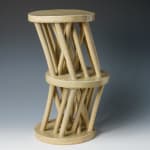Yamada Hikaru 山田光 Japanese, 1924-2001
H 40cm x W 25cm x D 20cm
Published ”CLAY WORK BY YAMADA HIKARU”, 2004, Sekaishisosha Co., Ltd
Exhibited : 1979 Exhibited at Isetan Department store
Further images
-
(View a larger image of thumbnail 1
)

-
(View a larger image of thumbnail 2
)

-
(View a larger image of thumbnail 3
)

-
(View a larger image of thumbnail 4
)

-
(View a larger image of thumbnail 5
)

-
(View a larger image of thumbnail 6
)

-
(View a larger image of thumbnail 7
)

-
(View a larger image of thumbnail 8
)

-
(View a larger image of thumbnail 9
)

-
(View a larger image of thumbnail 10
)

-
(View a larger image of thumbnail 11
)

-
(View a larger image of thumbnail 12
)

-
(View a larger image of thumbnail 13
)

Formal inspirations:
Tatlin's Constructivist tower was never built. It was a visionary architectural design by Russian artist Vladimir Tatlin and was never realized as a physical structure. The concept aimed at creating a monumental building using industrial materials such as glass and steel, symbolizing modernity in both form and function. This towering structure featured a twin helix rising up to 400 meters. In Tatlin’s imagination, visitors would have navigated its heights through various mechanical devices and pathways constructed of rods of steel and glass. The primary framework was designed to support four large suspended geometric structures.
Despite its groundbreaking vision, Tatlin's tower faced structural challenges from the outset. Although several wooden models were crafted (as depicted in the accompanying image), the practicality of the tower's construction was questioned. Nevertheless, the intellectual, ambitious, and modernist inquiries embedded in its design have earned enduring admiration. In the broader context of contemporary art, the tower's influence extends internationally, evident in works such as Ai Weiwei's 2007 sculpture "Fountain of Light," directly inspired by Tatlin's tower. Here, Yamada Hikaru's "disks and tubes" recalls the industrial materials originally envisioned by the architect for the tower's creation, as well as its geometric forms. The vision of a spiraling, geometric architectural wonder is invoked in this sculpture.












